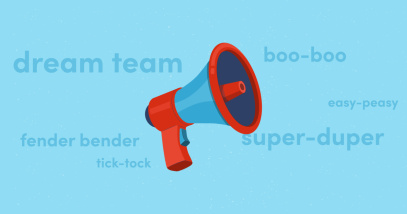Words That Pack a Punch

Moist has received much attention as a repulsive word in the English language. Is this in part because of its form, the string of sounds that make up the word? In general, are there words that evoke feelings, sensations and associations based on the aural qualities of word forms themselves? Onomatopoeias do this—those words that imitate the sound they represent, such as meow, achoo or hiss—but it turns out that sounds in words might symbolize sensations other than noise, like shape, size and texture. This is often termed sound symbolism.
Sound symbolism’s extent in language is the subject of ongoing research and debate, and our understanding of its origin and importance remains murky. That has not stopped word lovers from spotting patterns of sounds that elicit imagery and feelings at a level more granular than morphemes. Morphemes are those components of words that are generally seen to be the smallest meaning-making units of language. For example, in the word glossy we find a noun-and-morpheme, gloss, and another morpheme, -y, a suffix added to nouns to form adjectives. There is, it is argued, sound symbolism within gloss itself: a disproportionate number of English words beginning with the sound sequence gl- refer to a steady presence of light: glittery, glaze, glow, gleam, glisten and glimmer, for instance. This article takes stock of the many interpretations made of sounds in English that are perhaps more than arbitrary signs, that instead paint a picture, do a dance, tug on our heartstrings, or run fingernails over a chalkboard.
Sounding Off
Through the ages, thinkers have been curious about the idea of sound symbolism. In Plato’s book Cratylus, Socrates argues that good words bear a correspondence between sound and meaning. A millennium later, Dante put forth his own classification of words, which included the rather subjective categories of “combed out”, “shaggy”, “glossy” and “rumpled”.1 Later, Shakespeare employed harsh and gentle sounds to achieve dramatic tension in his sonnets. Take for instance these lines from Sonnet 62, in which a line with predominantly gentle sounds precedes a line with harsher sounds, emphasizing what is known as a volta, a shift in a sonnet in terms of theme or argument:
But when my glass shows me myself indeed
Beated and chopp’d with tanned antiquity…
The first line contains sounds often considered gentle: w, soft e (in when), multiple m’s, and long e (in me and indeed). The second line, which returns to the problem of the sonnet, contains a preponderance of sounds often considered harsher, in this case the ch sound and emphasis on plosive t’s (tanned antiquity).
In the 17th century, John Locke contended that the strings of sounds that make up words are arbitrary, so he saw no connection between a word’s meaning and its sound. This went against the view, found in the Book of Moses, that words were divinely inspired. But later, Alexander Pope in his poetic Essay on Criticism (1711) observed that words have material qualities, that “the sound must seem an echo to the sense”. Sound symbolism gained favour with Romantic poets of the 19th century, and in that era the French poet Arthur Rimbaud wrote a poem connecting vowel sounds with colours, which begins as such:
Black A, white E, red I, green U, blue O: you vowels,
Some day I’ll tell the tale of where your mystery lies(from the 2015 translation by George J. Dance)
Swiss linguist Ferdinand de Saussure agreed with Locke’s view and concretized in 20th-century linguistics the notion that, excepting marginal cases like onomatopoeia, there is no connection between words and what they represent. But challenging this notion around the same time was semiotician Charles Sanders Peirce, who argued for iconicity, the presence of a similarity between a sign and its meaning. Today, researchers in anthropology, linguistics and philosophy, as well as emerging fields like neurocognitive poetics, are theorizing about the existence of sound symbolism, and to what extent these sound associations are coincidental and made up, or are truly motivated and perceived, consciously or unconsciously.
While theorists puzzle over these questions, in practice we find an unlikely pair tinkering with word sounds and their associations: poets and advertisers. In ordinary conversation and reading, we tend to overlook the way words sound, paying attention only to the message. Poetry, by contrast, contains language that is more charged with meaning and more compact, using language heightened by metre, rhyme and repetitions of sounds. Meanwhile, advertisers on the hunt for a brand name look for sounds imbued with positive qualities that fit the product or service being sold in hopes of improving brand awareness and in turn investment and sales.
Sound Symbolism at Play in English
The following section presents a collection of putative sound symbols, or phonesthemes, ordered by what characteristic they are said to represent in English. Some of these may have occurred by chance, by shared etymology, by intentional coinages, or by shifts in form or meaning to fit a set.
Beauty or Softness
In some theories, vowels are seen as more euphonious than consonants, and consonants with “gentler” manners of articulation are seen as more euphonious than other consonants. Gentler consonants include the liquid consonant l, nasals (m, n) and semivowels (y and w). This view would perceive words like mellow as particularly beautiful.
In another view, the sounds that show up most often in words seen as pleasant and passive involve a somewhat different set: l, v, long e as in peace, soft e as in ever, voiceless th as in thistle, voiced th as in this, m and z.2 A word like lovely has some of these so-called pleasant sounds, as do the popular names Emily and Elizabeth. In some views, it is a combination of various other factors that make for beautiful words: linguist David Crystal proposed that words are likelier to be beautiful if they contain three or more syllables, have primary emphasis on the first syllable, involve multiple manners of articulation (such as stop consonant g, fricative s and approximant r), and contain the soft sounds m or l, among other criteria.3 These properties would account for the beauty of gossamer, melody and rosemary, among others.
Ugliness or Harshness
Cacophony is often caused by a combination of stop consonants, which are pronounced by obstructing the airflow in the mouth completely, such as p, t and k. It seems that Edgar Allen Poe was making use of the harshness of t in his poem The Bells:
Hear the loud alarum bells—
Brazen bells!
What tale of terror, now, their turbulency tells!
In some views, harsh sounds also include sh as in shout, oo as in brute and r as in murder and roar.4 Some propose that the facial expression made during the articulation of a sound can contribute to its pleasantness or unpleasantness; for example, the articulation of sh and oo involves a sort of grimace. Additionally, while v is considered a euphonious sound in words like dove, when the sound is exaggerated word-initially, the facial motion can resemble a snarl, as in vile and vicious. Compare these articulations with the long e found in words like lovely and serene, which has us articulating a sort of smile, also done when saying cheese! while smiling for a photo.
The sounds s and sh, when emphasized, can also feel negative in that they imitate hissing. Milton’s Paradise Lost (1667) evokes hissing in several passages involving Satan. For example, when Satan ponders his rebellion, he says, “how soon unsay what feigned submission swore”.
Many English swear words feature harsher sounds: the seven curse words that comedian George Carlin famously listed as unspeakable on television all contain hissy sibilants or voiceless stops.5 The presence of sibilance in piss could explain why it feels more vulgar than pee (the latter also has the supposedly pleasant ee sound).
Harsh sounds can lend memorability to a brand and evoke the quality of durability: this was the thinking behind George Eastman’s choice of Kodak for his camera brand. Brand names Pepsi and Coca-Cola are also seen as memorable for this reason.
Disgust
We find the yoo sound in words expressing disgust, like putrid, puke and spew, and the vowel in yuck is found in several words involving disgust, like muck and crud.6 The Smucker’s brand of jam seems to acknowledge the disgust involved in -uck in their tongue-in-cheek slogan, “With a name like Smucker’s, it has to be good”.
Some words evoke a reaction of nausea and disgust for the word itself—the way it sounds—and not due to its meaning; this phenomenon is known as word aversion. One of the most hated words in popular culture is moist, which is seemingly due to the word itself rather than solely what it represents, as its synonym damp is not the subject of the same ire. Exactly why moist receives such vitriol (with emphasis on the snarly v!) is somewhat of a mystery, but it may relate to the dissonance caused by the word’s positive associations with food (a delicious moist cake) and negative or sexual associations with bodily functions (sweating, lubrication, etc.), and some cite the mouthfeel of the word as unpleasant, with some reporting a dislike for the mouthfeel of ointment for the same reason.7
Physical Attributes
Roundness or Spikiness
Sounds associated with roundness are oo, m, oh and b, and those associated with spikiness are k, t and short i as in prick.8 The “rounder” sounds involve lip articulation, whereas the “spiky” sounds involve tongue articulation. This idea gained popularity from studies that present two images, one round and the other spiky, and have people choose which should be named maluma or bouba (words with “round” sounds) and which should be named takete or kiki (words with “spiky” sounds). Other proposed spiky sounds are diphthong ai as in spine or spike, and ur as in spur.
Another representation of roundness is found in -rl words, as in burl, pearl, and gnarl. This -rl sound is said to also represent curling in words like swirl, curl, twirl and unfurl.
Solid Mass
The sequence -ump is noted in words indicating a solid mass, including lump, clump, stump, rump and Humpty Dumpty, a name for a short and dumpy egg-shaped nursery rhyme character. A similar sequence, -omp, may be related, as it denotes the movement of a solid, heavy mass in words like stomp, clomp and whomp.
Size
Across many languages, it has been found that high front vowels indicate smallness and low vowels indicate largeness. High front vowels involve a tongue placement that is raised and brought toward the front of the palate, and such vowels include the short i found in little and the long e found in teensy, in wee, and in the diminutive suffix -ie or -y as in toesies and cutie. These vowels require more constriction in their articulation and have a slightly higher-pitched sound.
Examples for low vowels in English that represent largeness include ah/aw as found in a lot and in the emphasized syllable of colossal, the open a vowel as in vast and splash (a big sound) and oh as in bellow (another big sound). These low vowels involve opening the mouth wide and lowering the tongue, creating a larger cavity in the mouth and a slightly lower sound.
The saying “Many a mickle makes a muckle” has words that, despite their obscurity, clearly communicate smallness (front-vowelled mickle) and largeness (muckle with its contrasting, lower vowel). Compare also jingle, the sound of small bells, and jangle, the clang of larger bells. The antonym pair big and small, however, provides a counterexample to this tendency.
Size can bleed into other qualities, so smallness can relate to lightness, youngness and weakness (as in pipsqueak), and largeness can evoke heaviness, strength or richness. For example, a study showed that the made-up ice cream brand Frish, containing a high front vowel, was associated with iciness and wateriness, whereas the preferred name Frosh, containing a low back sound, was associated with richness and creaminess.9 Another quality found to be connected with size is proximity versus distance in space or time. Compare high front-vowelled here, this and present-tense drink with further-away and lower-vowelled there, that and past tense drank/drunk.
Actions and Movement
Force
The consonant cluster str- is often found in words denoting force or power, as in strength, strive, strike, stroke, stress and stride.
Many words ending in -ash express a forceful movement, often ending in an impact that produces a long sound or fragments. Consider crash, bash, mash and splash.
Abruptness
Words beginning in a voiceless stop (like p, t or k), readily express a sound that begins abruptly, as in cough, and peal (say, of thunder). Likewise, words ending in a stop can express abrupt sounds, as in “short, sharp shriek”, or crack or plop.
The combination -nt (a nasal stopped short by a stop) can represent an action or sound being abruptly stopped, as in stunt and pent. Compare grunt meaning “a short, guttural sound” and groan, whose drawn-outness could be hinted at by the continuous nasal consonant at the end.
Dashing Through
Fricatives—consonants produced by forcing air through a narrow opening in the mouth, including s, sh, h and z—can represent an object moving audibly and quickly through the air, as in whoosh, whizz and zip.
Many words beginning with sw- indicate moving through air or water: swoop, swerve, swim, swing. Swish shows a combination of sw- and an airy fricative ending.
Smooth Moves
Sl- is found in many words for moving along a wet or low-resistance surface, such as slide, slippery, slither and slink. It is also found in many words describing a liquid-y substance, such as slime, slush, slobber and sludge.
The -oop sound is found in words describing a curved movement, as in hoop, scoop and stoop.
Luminosity
As mentioned earlier, gl- can represent the presence of a steady light in words like glow. Additionally, fl- may represent moving light, as in flicker, flash and flare.
Sensational Sounds
Whether sound symbols occur by chance or are indeed motivated in some way, language-conscious people will make sensory and emotional associations with words and word sounds. It appears that some words over history have been created, blended, or altered in form or meaning to fit into certain phonestheme groups. These meaning-rich sounds can add colour and texture to poetic writing, just as they can make or break a brand name. Perhaps you have some associations of your own to add to the list!
-
New Princeton Encyclopedia of Poetry and Poetics, edited by Alex Preminger and T.V.F. Brogan (1993), s.v. “Sound”. ↩
-
Whissell, Cynthia. “Sound Symbolism in Shakespeare’s Sonnets: Evidence of Dramatic Tension in the Interplay of Harsh and Gentle Sounds.” English Language and Literature Studies, 7, no. 4 (2017): 1-10. https://doi.org/10.5539/ells.v7n4p1 ↩
-
Crystal, David. “Phonaesthetically Speaking.” English Today 11, no. 2 (1995): 8–12. https://doi.org/10.1017/S026607840000818X ↩
-
Whissell, ibid. ↩
-
Aryani, Arash, et al. “Why ‘piss’ is ruder than ‘pee’? The role of sound in affective meaning making.” PLOS One (2018). https://doi.org/10.1371/journal.pone.0198430 ↩
-
Roche, Sarah, L.J. Shrum and Tina M. Lowrey. “The Aesthetics of Brand Name Design: Form, Fit, Fluency, and Phonetics.” In The Psychology of Design, edited by Rajeev Batra, Colleen Seifert and Diann Brei, 180-186. New York: Routledge, 2015. ↩
-
Malady, Matthew J.X. “Why Do We Hate Certain Words?” Slate. April 1, 2013. ↩
-
Sidhu, D.M., et al. “Sound symbolism shapes the English language: The maluma/takete effect in English nouns.” Psychononic Bulletin Review 28 (2021): 1390–1398. https://doi.org/10.3758/s13423-021-01883-3 ↩
-
Roche et al., ibid. ↩




